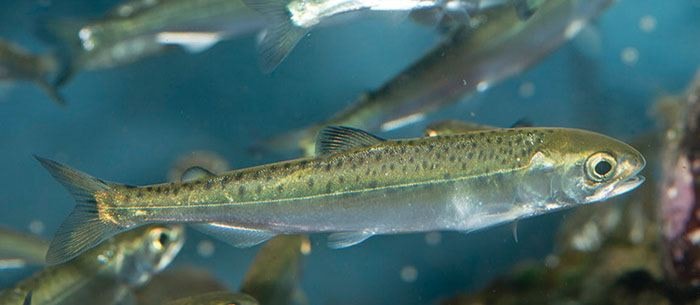The old saying about you can “take it to the bank” became very clear for the future of the world famous Campbell River chinook run March 16.
Without that bank, said former Quinsam River Hatchery manager Dave Ewart, the 2016 return of the historic run would have been lost.
Ewart was speaking to a crowd of people at the Discovery Passage Aquarium speaker’s event at the Maritime Heritage Centre. The event was sponsored by North Island College and the Campbell River Mirror.
Ewart was discussing the impact of the historic flooding of the Campbell River in late 2016. He showed an overhead of the new spawning bed paid for by the Campbell River Salmon Foundation.
“We did a drone flight up to count the fish and there were 500 or 600 chinook up there, it was incredible, they were just loving it,” he said, showing a picture of the new gravel and the salmon using it.
The next picture, taken only a week later after the floods, showed a different picture. “There was no gravel,” he said. And the salmon eggs deposited there? No chance.
Located at what some local anglers will know as the Helicopter Pool, the spawning gravel was put in during the summer fisheries window of 2016.
(The Helicopter Pool is adjacent to the helicopter landing area on your right as you driver into the John Hart Generating Station parking lot.)
That gravel has been washed downstream, some went to the main riverbed but most of it ended up in the spawning channel of what is known as the Lower Island. It has stopped the flow of water to that section of the river which was also used as spawning area for chinook, coho and chum salmon. The 2016 wash out is something that has happened on a frequent basis since the gravel was first installed in the early 1990s.
“It’s not just the flood, it can handle the flood if it happens later because the fish have hatched and they get down in that gravel,” said Ewart. “But if it happens in spawning when those eggs are just newly in the gravel or not eyed yet — if they’re eyed they’re tough — but when they’re in the first 30 days, they’re really sensitive.
“So this happened at the worst time possible for spawning and egg development. For me, it’s a reason why there’s a hatchery. Because it’s a bank account. I think the only eggs that are going to survive out here this year are in the incubator right now. It’s frustrating.”
Mike Gage, former chairman of the Campbell River Salmon Foundation, in the question and answer session, blamed BC Hydro
He suggested that BC Hydro didn’t manage the system properly, didn’t spill water from the system when they knew a storm was coming.
Ewart saw it differently.
“When I first started with the hatchery we’d get one flood every 10 years or something and they were scary and the most dangerous thing I ever did was working on floods,” he said. “Twenty years in, it was once every five years and when I left it was twice a year you get big floods. And this was a doozy this year. I don’t know how you would handle that amount of water.”
Ewart was backed up by Sandra Mulligan, a biologist, who sits on BC Hydro’s select committee on the John Hart Generating Station relocation project.
She said she questioned BC Hydro at length on their flood management during a meeting after the event.
She said BC Hydro staff were forthcoming with all information and they did all they could to mitigate the damage.
